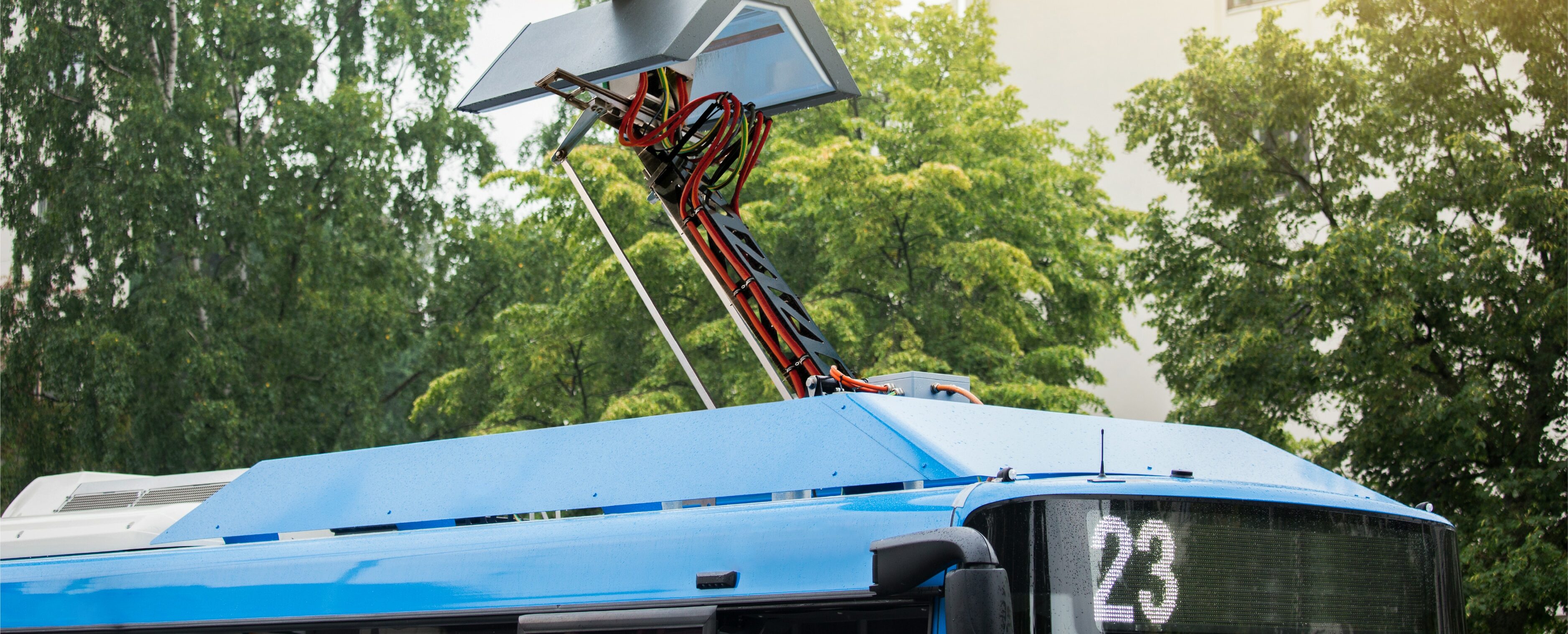Opportunity Charging for EV Buses – Pantograph Technology
Daniel Eustace, Project Director
Public transport plays a crucial role in our lives, shaping where we live and work. It also has an impact on the environment, and electric vehicles are playing a key role in reducing the carbon emissions impact from buses, helping us achieve our net zero targets.
Electric buses need charging infrastructure to keep them moving, and the powerful pantograph charger is a relatively new innovation in today’s EV bus infrastructure. There are currently fewer than 10 pantographs in the UK, with 3 in and around London.
The pantograph delivers ‘opportunity charging’ for buses – meaning vehicles charge whilst on a route rather than having to return to depot for charging.
Case Study – Kent County Council
Kent County Council is one of the pantograph pioneers. The Council is currently electrifying its Thameside Fastrack Thameside BRT, a high-frequency Bus Rapid Transit network that carries 2.75 million passengers a year. Opportunity charging was a key requirement, and the Council is using 6 powerful pantograph chargers at 3 locations.
It takes less than 6 minutes to top-up charge at each end of the route while passengers board.
The Council appointed VEV to build, manage and maintain the specialist pantographs. Read the case study here > Kent County Council Case Study.
Opportunity Charging vs Depot Charging
Charging a vehicle away from the depot – opportunity charging – can significantly improve bus fleet performance by reducing the amount of bus downtime and increasing vehicle range.
If buses have to return to depot to charge, time must be allocated in the schedule for this. Opportunity charging can enable 24/7 operation without disrupting schedules for return-to-depot-charging.
Route distances will be limited by the vehicle range possible on a single charging session at the depot. Whereas opportunity charging can enable buses to operate on longer routes and connect into new residential areas that might otherwise be out of range for traditional electric buses.
Another difference is that opportunity charging can reduce the vehicle’s battery requirement in terms of size and cost of the battery.
A physically smaller vehicle battery increases the available capacity for passengers on the bus as well as reducing the weight of the vehicle which reduces the power requirement.
Taking some of the charging requirement out of the depot to opportunity charging during service, can also help balance electrical demand at the depot.
Pantograph Technology
Pantograph technology has been with us since the late 1800’s. Invented by Walter Reichel, a Senior Engineer at Siemens & Halske (who later became part of technology giant Siemens) the first pantograph was utilised on the Baltimore & Ohio Rail Road in 1895.
In the rail/tram industry the pantograph arm was fixed to the vehicle and traditionally utilised a graphite strip to maintain contact to the conductor and deliver power into the vehicle.
Pantograph technology has evolved and is now used in the EV world, predominantly with buses. Pantograph charging allows electric buses to charge while in service by connecting to an overhead charging station. There are two distinct variations of pantographs:
- Pantograph-up – as the bus drives under the station, a pantograph arm on top of the bus rises up and connects with the overhead charging station.
- Pantograph-down – the scissor mechanism is on the overhead infrastructure and drops down to make contact with the bus to charge.
Pantograph chargers are high powered and typically offer between 150kW – 600kW of charging power meaning a vehicle can charge up to 5.25 miles a minute. (Assuming 450kW of power and efficient rate of .7mile/kwh.)
Pantograph Implementation Considerations
Pantograph charging requires careful planning and upfront investment as part of a fleet electrification program. By strategically placing pantograph chargers along a bus route, longer more challenging routes can be electrified, sooner.
Pantograph charging stations should be installed along existing routes that are unlikely to change. If a route changes in the future, the charging station may become a stranded asset, going unused and wasting resources.
When combined with charging at the bus depot, pantograph opportunity charging provides flexibility and redundancy. Buses can charge at the depot overnight and top-up during the day. This balances the electrical load and takes advantage of lower electricity rates at night.
Bus depots are typically tight on space and utilise every square inch of the site. Depot charging is also likely to require a new power connection greater than that of a pantograph. Opportunity charging on bus routes may alleviate some of these pressures with fewer EV chargers required at the depot.
Wireless RFID technology is used to enable communication between the bus and the pantograph. This means that the bus can charge without the need for the driver to exit the vehicle and whilst passengers are embarking and disembarking the vehicle meaning optimum efficiency.
Pantograph technology is certainly an innovation that can contribute to the UK’s journey toward zero emissions and more sustainable transportation options.
Get in touch with one of our expert team and find out more about how VEV can help streamline your EV transition.
